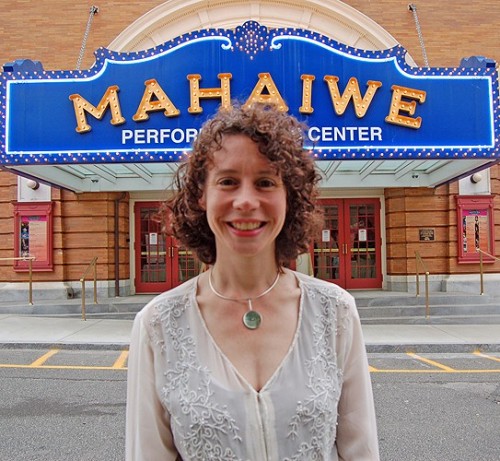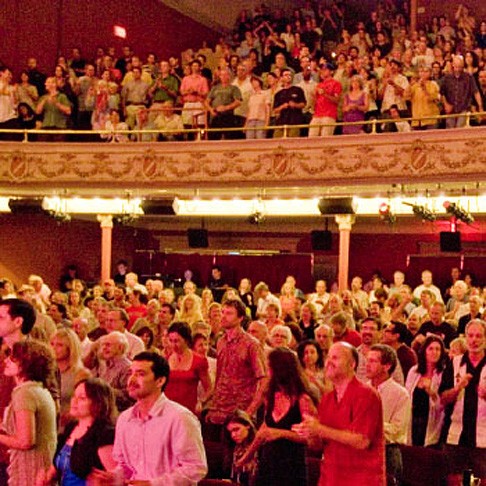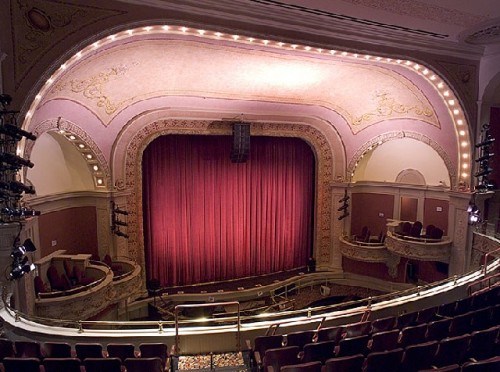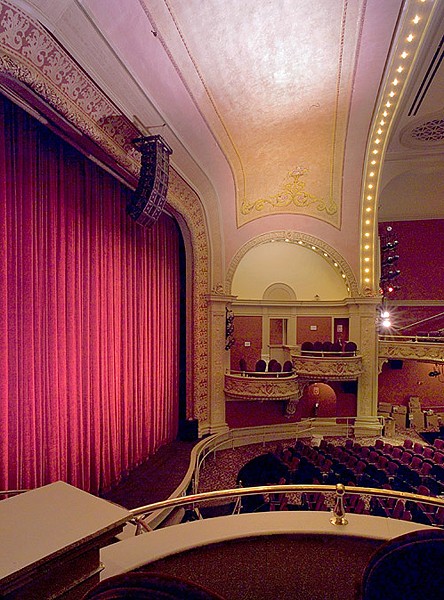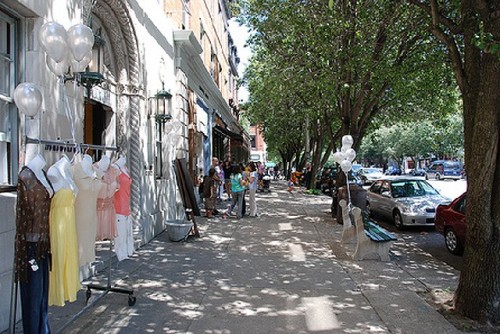Transforming Great Barrington: Beryl Jolly and the Mahaiwe
The Arts Bring a Community Together
By: Larry Murray - Jun 10, 2009
When Beryl Jolly talks, it's never about her, but about the community she loves, Great Barrington, and the Mahaiwe Performing Arts Center where she is Executive Director. Jolly is the leader of a full time staff of five, and behind this platoon of planners is a huge cadre of "friends" who contribute mightily to the success of both the theatre and the community in which it operates.
Once considered daring, these days there is nothing original about a small community reviving a neglected theatre. Infusing it with activity is the hard part. More than just planners, it takes a community to make it happen. The Mahaiwe is a case study of how these projects should be done, and there are two distinct parts to doing it, the before and after; the complicated funding and restoration of an old theatre, running a new one, and staying solvent. So this story is not only about Beryl Jolly, Executive Director of the current operation. It is also about Lola Jaffe, who remains at the head of the operation, as the Founding President and Chair of the Board of Directors. Two people with very similar names, Jaffe and Jolly. You can't make these things up. Lola Jaffe, and her late husband, Edwin, got things moving in the first place.
The Mahaiwe (its name is from the Mohican word for downstream) was opened in 1905 as a Vaudeville stage and converted into a movie house in 1930. It continued in that role until 2000 when the theater was used as a rehearsal and performance space for the Berkshire Opera Company . In its hundred years, the Mahaiwe never really ceased operations, but its structure, mechanical, and electrical components were in serious need of upgrading. The interior had become sad and faded.
Lola Jaffe, long an arts mover and shaker, got the ball rolling. She envisioned a revitalized Mahaiwe, and with her neighbors and friends, spearheaded the formation of a non-profit organization in the theater's name. This opened the door to serious planning with Hugh Hardy and Associates, a noted theatre architect. Her group sought out the essential funding, accrued from private sources, state and federal assistance, and $1.6 million in federal historic tax credits. She gives the community kudos and applause for stepping up to the plate. Much credit goes to Representative Smitty Pignatelli for landing the $1.6 million in federal historic tax credits that acted as a major motivator to move the project along.
All told, $9 million had to be raised. This compares with the Colonial Theatre's $22 million in Pittsfield and the Mohawk Theatre in North Adams Phase One of $7.7 million which covers the auditorium but does not include any expansion of the stage area.
The Mahaiwe's original architecture was preserved and was so carefully done that the Mahaiwe has been listed in the National Register for Historic Places. Yet other elements had to be completely updated including bathrooms, electical, HVAC, box office, stage rigging and a hundred other details. A great deal of love was bestowed on this dowager of a theatre, restoring it to a subtle and elegant, if understated, beauty. The work was completed between 2002 and 2004, and still continues as funds allow. The latest is a proper backstage area for visiting artists to use for pre-show preparations. This was funded, two years ago, through a capital improvement grant from the state.
Once the Mahaiwe was upgraded, the second half of the project began, and this is where its significant economic impact on Great Barrington comes into play. To begin with, the physical restoration of the building provided considerable employment for local contractors and tradesmen - 80% of those $9 million expenditures remained in the Berkshires. Once completed, the ongoing schedule of performances and resultant audiences lifts the entire downtown as well.
"We are lucky to have so many great restaurants near the theatre, from the Castle Street Cafe next door, to Pearl's, Allium, Ruby's, The Napa, and Siam Square, they all are part of the fun of coming downtown for a show," enthused Jolly, "and sometimes you can't even get a seat when it gets close to showtime." Visitors to Great Barrington sometime comment on the scarcity of parking spaces, but the Mahaiwe box office manager provided us with a map showing the ample parking nearby, lots of it, especially during evenings and weekends. Their website also has a map you can download.
The activity in downtown Great Barrington is an impressive contrast to that of other Berkshire downtowns some of which have lost their vitality. Pittsfield is making a comeback since the Colonial and Barrington Stage theatres opened there. In Great Barrington, a good portion of the resurgence has to be given to the healthy mix of shopping and entertainment that has evolved over the recent years. Not only the Mahaiwe but the Triplex Cinema as well, an independently owned operation, also located in the heart of downtown. Its patrons compete with Mahaiwe audiences for on-street parking, and tables at the restaurants. This kind of competition makes businesses healthy.
Figuring out what sorts of live shows will appeal to the people who live in the area involves a lot of trial and error, but Jolly has figured it out. "To begin with, we have two booking consultants," she notes, "And lots of comments from our audiences. We know, for example, when something sells out that we did right by the community, but we also note the quality of the audience reaction. Even if the house isn't full, we know from an enthusiastic response that we chose well."
Jolly has a background in theatre, having acted in high school before studying theatre at Brandeis. She then interned at the Williamstown Theatre Festival before moving to New York where she worked with Joe Papp's Public Theatre and Shakespeare in the Park, on both classics and new plays.
She has two daughters, 4 and 8, (she describes them as "almost" 5 and 9), and has a special affinity for family attractions. She brings her girls to many of the daytime offerings at the Mahaiwe. But they also love to travel over to Jacob's Pillow for the free late afternoon performances at the Inside/Out stage. Speaking as a mother she notes happily that "this is just an amazing community in which to raise children."
With the economics of the arts having taken a beating with the troubled economy, she wrestles with both a personal budget - all staff members took a pay cut this year - and that of the Mahaiwe. "We lost two full time positions this year, too. We pared costs back to reflect a tougher economic climate. Yet things are holding pretty steady. Last Fall, the state's budget cuts cost us $150,000 of a $200,000 grant, and that was painful. Still, our attendance is holding up - down only a little from 78% to 70% of capacity, which is good news."
"What is genuinely exciting for us is that the community continues to rally around us and our Friends of the Mahaiwe program is up to 800 members, which is double what it was just a year ago. This core group of mostly South County supporters is our pride and joy. They provide us with vital funds and we give them lots of attention, benefits and thanks for their loyalty and encouragement."
"Half our audience comes from south county and the other half is the rest of Berkshire county and the tristate region. We even have members from Pennsylvania, Rhode Island and Maine - plus quite a few New Yorkers who visit or have homes in the area. They're all family to us."
This core group supports an amazing number of performances. "The goal is diversity. From classic movies to numerous family oriented shows, to dance and pop, classical and bluegrass, theatrical and acrobatic acts there is enough diversity on our calendar to be pretty sure there is something at the Mahaiwe to interest everyone."
"We constantly think about what to offer, even in the summer when there are so many other choices. So we look to see what we can contribute that is different, and fills a need that might otherwise go unmet. That's why we have picked up Bebe Neuworth, for example, so that we complement the other theatrical attractions, not compete with them. "
"We are going every weekend, but should we do more? Are there some weeknights that would make sense as well? We do host a lot of community groups during the week, like the Fairview Hospital Gala, Close Encounters With Music, the Daniel Pearl tribute, or last year's benefit for fuel assistance. We also host a lot of community performers who often present shows in collaboration with local charities. Those are true win-win situations. They not only enrich Great Barrington, but provide us with still more reasons to come downtown."
Jolly admits it is tough to make money with such a modest capacity (about 700 seats), but then again even ballparks and stadiums are rarely profitable. So we asked, just how much needs to be raised, and where does it come from? "We have to raise about $750,000 a year towards our $1.3-1.4 million budget - and about half of that is from ticket income which is a significant accomplishment for our fifth season - but still a lot to raise. The good news is that 40% of this comes from individuals as donors, or sponsors or as basic members. There is some corporate and foundation support including national foundations too. There are not a lot of big corporations in the Berkshires as you know, and we value those we have for their help." The banks in the area have been supportive. Likely, they are more aware than most of the key role the Mahaiwe has in keeping the region vibrant. The lobby, for example, is named for the Berkshire Bank.
Wondering what events have been the most surprising, Jolly pointed to the Metropolitan Opera broadcast series. "It's been selling out non-stop and already our members are clamoring for the new season to get underway. And it is almost blizzard proof - 400 local people turned out for Hansel and Gretel in the middle of a snow storm. If they lived further away, they might not have ventured out."
"Similarly," she continued, "we are excited to have the National Theatre of London scheduled to do a High Definition broadcast of Helen Mirren in Phedre on June 25th, which is new to us and the United States. It will be followed by All's Well That Ends Well on October 1 with Claire Higgins. Some of the scheduled works are less well known, but once audiences get familiar with this, especially through the behind the scenes elements, I think it will grow and develop into a must-see for theatre lovers. How often do you get a chance to see Helen Mirren or Claire Higgins?"
What's most interesting about the coming season, just announced, is that there is indeed something for everyone.
That the Mahaiwe Performing Arts Center is on the right track is seen in the depth of the support from the people who take advantage of it. This venerable old theatre has clearly survived its first hundred years with a new facelift, and is ready for the next century. It is the sort of success that only a dedicated board and staff can accomplish with the help and support of the community in which it operates. When all are in syncronization, great things can and do happen.
A schedule of 2009-10 attractions is posted in a separate story. Information on upcoming performances and tickets can be found on their website which is constantly updated. www.mahaiwe.org

